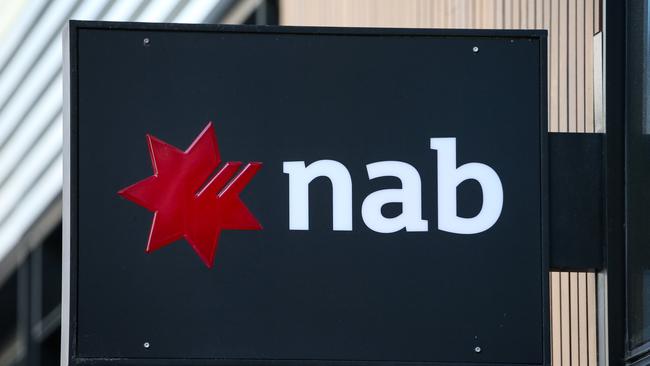NAB cash profit jumps to $7.1bn on success of business banking
Ross McEwan says its analysis shows the bank has billions of dollars in high-risk home loans as interest rates and inflation start to bite and house prices fall up to 20 per cent.
National Australia Bank has identified close to $200bn of riskier exposures across its home lending and business books, as it braces for higher rates and rising inflation to punish its most indebted customers.
The bank’s own analysis, released alongside its full-year results on Wednesday, pointed to $177bn of home loans that NAB wrote between 2019 and 2022, all of which had an average serviceability threshold below 6 per cent. Those same thresholds should now be sitting at about 7 per cent, and will move even higher as rates rise.
Even as the broader economic outlook darkens, NAB chief executive Ross McEwan is confident Australia can avoid a recession and navigate a soft landing.
“All of the numbers look like Australia will continue to grow in GDP next year, which is good given what’s going on in the world,” Mr McEwan told The Australian.
“So all of our big trading partners are slowing down (but) we could still have growth in GDP next year and into 2024; I think that would be a good landing.”
The market can handle a cash rate of 3.6 to 4 per cent, he said.
“There will be pain, there will have to be pain, unfortunately. That’s what it’s all about, putting interest rates back up again off the emergency settings they’ve been on.”
NAB expects the cash rate to peak at 3.6 per cent by the end of 2023 and sees unemployment rising to 4.2 per cent by the same time.
The higher cash rate, currently sitting at 2.85 per cent, means borrowers who took out loans through Covid are already facing much higher repayments and increasingly the prospect of falling into negative equity.
Among NAB’s higher risk exposures, the greatest danger lies with those that have minimum repayment buffers and high loan-to-value ratios. NAB estimates $10bn of loans are with borrowers that have repayment buffers of less than 12 months and LTV ratios above 80 per cent.
But as borrowers increasingly dip into their savings to mitigate rising costs, and as house prices drop further, higher risk loans will increase.
NAB has identified a further $8.5bn of business loans “with loss potential” as it sees some businesses struggling in the more challenging environment.
At the same time, the lender is eyeing a fixed-rate cliff that won’t hit its peak until 2023: 78 per cent of NAB’s fixed rate loans expire over the next two years, with the biggest proportion — 32 per cent — tipping into variable over the six months to September 2023.
All up, $48bn of fixed rate loans will expire next year.
While the bank is not yet seeing customers get into difficulty from transitioning to variable from ultra-low fixed rate loans, it is “keeping an eye” on at-risk customers.

As NAB braces for a more subdued 2023, Mr McEwan said the lender had taken the decision not to compete aggressively on price in the home loan market.
“We will make choices to strike the right balance between volume and price for maintaining risk discipline. This may result in us growing low system for a period,” he said.
Meanwhile, NAB is forecasting house prices to plunge a further 15 per cent from here, further pressuring borrowers who may be contemplating selling as repayments balloon. House prices declined 5 per cent nationally by the end of September.
NAB’s cash profit jumped to $7.1bn for the 12 months ended September 30, up 8.3 per cent on the prior corresponding period, underpinned by volume momentum, rising interest rates and a balanced approach to cost discipline, the lender said.
The result was in line with analyst expectations and capped off a bank earning season that saw the majors report a combined cash profit after tax of $28.5bn, up 7.2 per cent on last year, according to KPMG.
Despite NAB meeting consensus targets, its shares stumbled through the day’s trade, dipping as much as 2.7 per cent before paring the losses to close 0.9 per cent lower at $31.66.
Also released was NAB’s annual report, which showed Mr McEwan pocketed $3.9m in pay for 2022, just shy of the $4m he took home the year prior.
As well as this was NAB’s climate report, showing the lender has established interim targets for reaching net zero across four sectors: power generation, thermal coal, oil and gas and cement.
Over the year, business and private banking saw a 21.5 per cent jump in earnings to $3bn on the back of volume growth and higher margins, as well as lower credit impairment charges. This was partially offset by rising operating expenses.
Corporate and institutional banking earnings also jumped, rising 35 per cent to $1.6bn, reflecting strong volume growth and higher margins, alongside lower impairments.
But personal banking earnings dipped 4 per cent to $1.6bn as home lending competition crimped margins.
NAB’s New Zealand operations, meanwhile, saw earnings growth of 14 per cent.
Revenue increased 8.9 per cent, but the net interest margin, a key measure of profitability, fell 6 basis points to 1.65 per cent.
Excluding a 1 basis point increase from the Citi consumer business, which NAB acquired in June, and an 8 basis point reduction from markets and treasury, NIM rose 1 basis point. This reflected higher earnings on deposits and capital due to rising interest rates, partly offset by home lending competition.
Expenses jumped 5.8 per cent over the year. Excluding the impact of the Citi consumer business, expenses rose 3.9 per cent, with key drivers including higher remuneration and increased financial crime and remediation spend.
UBS banking analyst John Storey said it was a clean & in-line result.
“The only potential negative for us is possibly around costs, a slightly softer fourth quarter exit NIM (at) 1.72 per cent, and NAB’s guidance around funding mix/cost,” he said.
NAB declared a final dividend of 78c per share, bringing the full-year payout to $1.51 per share, fully franked.






To join the conversation, please log in. Don't have an account? Register
Join the conversation, you are commenting as Logout